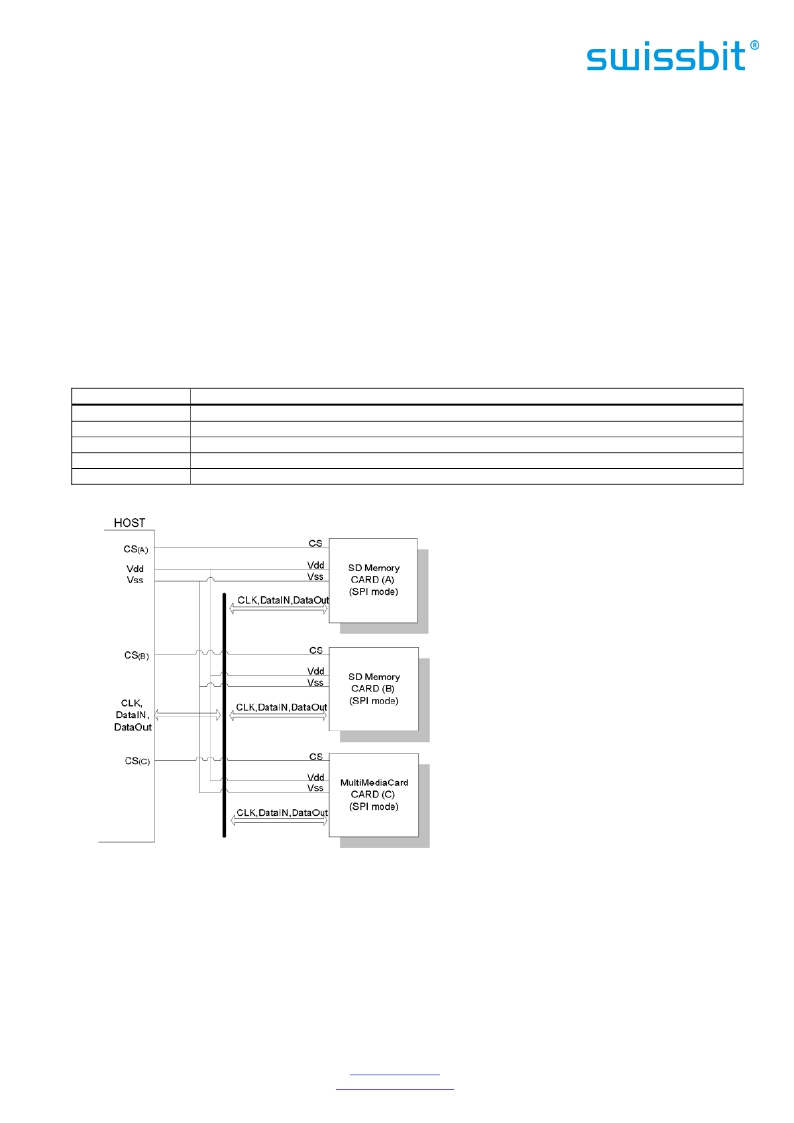- 您现在的位置:买卖IC网 > Sheet目录251 > SFSD8192N1BW1MT-E-QG-111-STD (Swissbit NA Inc)FLASH MICRO SD 8GB EXT TEMP

8.1.2 SPI Bus Mode Protocol
The Serial Parallel Interface (SPI) Bus is a general purpose synchronous serial interface. The SPI mode consists of a
secondary communication protocol. The interface is selected during the first reset command after power up
(CMD0) and it cannot be changed once the card is powered on.
While the SD channel is based on command and data bit streams which are initiated by a start bit and
terminated by a stop bit, the SPI channel is byte oriented. Every command or data block is built of 8-bit bytes
and is byte aligned to the CS signal.
The card identification and addressing methods are replaced by a hardware Chip Select (CS) signal. There are no
broadcast commands. For every command, a card (slave) is selected by asserting (active low) the CS signal.
The CS signal must be continuously active for the duration of the SPI transaction (command, response and data).
The only exception occurs during card programming, when the host can de-assert the CS signal without affecting
the programming process.
The bidirectional CMD and DAT lines are replaced by unidirectional dataIn and dataOut signals.
Table 19: SPI Bus Signals
Signal
/CS
CLK
Data In
Data Out
Vdd, Vss
Description
Host to card chip select
Host to card clock signal
Host to card data signal
Card to host data signal
Power and ground
Figure 9: SPI bus topology
8.1.3 Mode Selection
The SD Memory Card wakes up in the SD mode. It will enter SPI mode if the CS signal is asserted (negative) during
the reception of the reset command (CMD0) and the card is in idle_state . If the card recognizes that the SD mode
is required it will not respond to the command and remain in the SD mode.
If SPI mode is required the card will switch to SPI and respond with the SPI mode R1 response.
The only way to return to the SD mode is by entering the power cycle. In SPI mode the SD Memory Card protocol
state machine is not observed. All the SD Memory Card commands supported in SPI mode are always available.
During the initialization sequence, if the host gets Illegal Command indication for ACMD41 sent to the card, it may
assume that the card is Multimedia Card. In that case it should re-start the card as Multimedia Card using CMD0
and CMD1.
Swissbit AG
Industriestrasse 4
CH-9552 Bronschhofen
Switzerland
Swissbit reserves the right to change products or specifications without notice.
www.swissbit.com
industrial@swissbit.com
Revision: 1.00
S-300u_data_sheet_Rev100.doc
Page 12 of 19
发布紧急采购,3分钟左右您将得到回复。
相关PDF资料
SFUI4096J1BP2TO-I-DT-211-STD
FLASH DRIVE USB MODULE U-110 4G
SGN08G64B3BB2SA-CCWRT
SDRAM DDR3 8GB 204 SO-DIMM
SGN08G72G1BB2SA-CCWRT
SDRAM DDR3 8GB 204 SO-UDIMM
SGP1200-12G
FRONT END AC/DC 1133W 12V
SL05.TCT
TVS ARRAY DATA INTFC SOT-23
SL24T1G
TVS LO CAP 300W 24V ESD SOT23
SLD10U-022-B
DIODE TVS AXIAL HI-POWER
SLP-2-413-01
SNAP LOCK PINS TEAR-DROP .413"
相关代理商/技术参数
SFSD8192N1BW1MT-I-QG-111-STD
功能描述:Memory Card microSD? 8GB Class 10 SLC 制造商:swissbit na inc. 系列:S-300U 零件状态:有效 存储器类型:microSD? 存储容量:8GB 速度:10 类 技术:SLC 工作温度:-40°C ~ 85°C 标准包装:120
SFSD8192N2BM1TO-I-LF-2A1-STD
功能描述:Memory Card microSDHC? 8GB Class 10, UHS Class 1 MLC 制造商:swissbit na inc. 系列:S-45u 零件状态:有效 存储器类型:microSDHC? 存储容量:8GB 速度:10 类,UHS 1 类 技术:MLC 工作温度:-40°C ~ 85°C 标准包装:120
SFSD8192N3BM1TO-I-GE-2B1-STD
功能描述:MEMORY CARD MICROSDHC 8GB MLC 制造商:swissbit 系列:S-45u 零件状态:在售 存储器类型:microSDHC? 存储容量:8GB 速度:10 类,UHS 1 类 技术:MLC 工作温度:-40°C ~ 85°C 标准包装:1
SFSD8192N3BM1TO-I-LF-2CP-STD
功能描述:MEMORY CARD MICROSDHC 8GB PSLC 制造商:swissbit 系列:S-46u 零件状态:在售 存储器类型:microSDHC? 存储容量:8GB 速度:10 类,UHS 1 类 技术:pSLC 工作温度:-40°C ~ 85°C 标准包装:1
SFSDT-02-28-G-04.00-S
制造商:Samtec Inc 功能描述:.050 (1.27) SOCKET DISCRETE CABLE ASSEMBLY - Bulk
SFSDT-02-28-G-04.00-SR
制造商:Samtec Inc 功能描述:.050 (1.27) SOCKET DISCRETE CABLE ASSEMBLY - Bulk
SFSDT-02-28-G-06.00-DL-NUS
制造商:Samtec Inc 功能描述:.050 (1.27) SOCKET DISCRETE CABLE ASSEMBLY - Bulk
SFSDT-02-28-G-06.00-D-NUS
制造商:Samtec Inc 功能描述:.050 (1.27) SOCKET DISCRETE CABLE ASSEMBLY - Bulk
